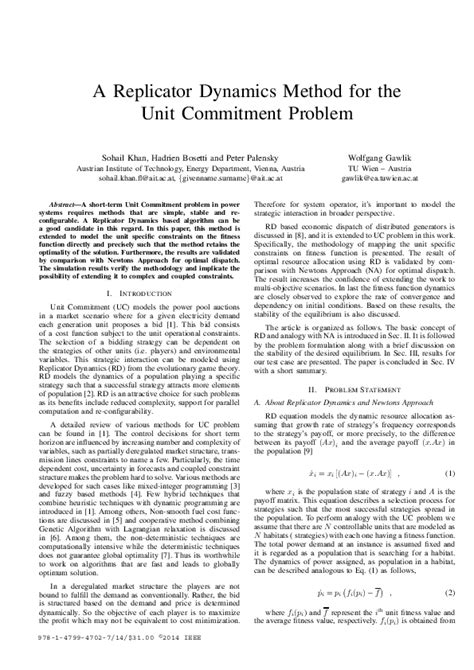finding omega limits of replicator dynamics | replicator dynamics draft pdf finding omega limits of replicator dynamics understand the behavior of replicator dynamics in such settings and furthermore develop an expansive unifying framework for understanding dynamics both in evolutionary games as well . 100. Normal values for ejection fraction (EF) Studies in healthy individuals suggest that the mean ejection fraction is 63% to 69%.
0 · the replicator dynamics pdf
1 · replicator dynamics examples
2 · replicator dynamics draft pdf
3 · replicator dynamics
You will likely feel very tired. Fatigue is one of the most common symptoms at the end-of-life phase. Even when you lie still, cancer saps the energy from your body. Expect to feel drowsy and .
In recent years, some concepts from biology have been applied to game theory to define the replicator differential equations that give dynamics of the adjustment toward Nash equilibrium in a competing situation. The general topic is called evolutionary game theory.The thesis of evolutionary dynamics is that strategies which have higher tness than the average should be more likely to survive and, therefore, their proportion should increase, whilst those .Replicator dynamics • pi(t) = #people who plays si at t; • p(t) = total population at t. • xi(t) = pi(t)/p(t); x(t) = (x1(t),., xk(t)). • u(x,x) = Σi xiu(si,x). • Birthrate for si at t is β + u(si,x(t)). • p& (i .understand the behavior of replicator dynamics in such settings and furthermore develop an expansive unifying framework for understanding dynamics both in evolutionary games as well .
In this paper we examine the relationship between the flow of the replicator dynamic, the continuum limit of Multiplicative Weights Update, and a game’s response graph.We explore asymmetry in fitness and show that the replicator-mutator equations exhibit Hopf bifurcations and limit cycles. We prove conditions for the existence of stable limit cycles for the .1.1 Deriving the replicator dynamic. In a finite population, let Nh(t) ≥ 0 be the number of individuals who currently use P. pure strategy h ∈ S. Let N (t) = h∈S Nh(t) > 0 be the total population. . Theorem 1 and Corollary 1 provide conditions that guarantee the convergence of the replicator equation’s solution to a desired output of a population game. Next, we present two .

The replicator equation (in its continuous and discrete forms) satisfies the folk theorem of evolutionary game theory which characterizes the stability of equilibria of the equation. The . We study these new nonlinear dynamics using a generalized rock-paper-scissors game whose dynamics are well understood in the standard replicator sense. We show that the .In recent years, some concepts from biology have been applied to game theory to define the replicator differential equations that give dynamics of the adjustment toward Nash equilibrium in a competing situation. The general topic is called evolutionary game theory.The thesis of evolutionary dynamics is that strategies which have higher tness than the average should be more likely to survive and, therefore, their proportion should increase, whilst those who have a lower tness should decrease over time. This .
Replicator dynamics • pi(t) = #people who plays si at t; • p(t) = total population at t. • xi(t) = pi(t)/p(t); x(t) = (x1(t),., xk(t)). • u(x,x) = Σi xiu(si,x). • Birthrate for si at t is β + u(si,x(t)). • p& (i = [β+ u s i, x)−δ]pi • p& = [β+ (,u x x )−δ]p • x& ( (, i =[u s i, x)− u x x )]x i • x& (, ) i = u s i .understand the behavior of replicator dynamics in such settings and furthermore develop an expansive unifying framework for understanding dynamics both in evolutionary games as well as two-agent and multi-agent settings as well.
In this paper we examine the relationship between the flow of the replicator dynamic, the continuum limit of Multiplicative Weights Update, and a game’s response graph.We explore asymmetry in fitness and show that the replicator-mutator equations exhibit Hopf bifurcations and limit cycles. We prove conditions for the existence of stable limit cycles for the dynamics in the case of circulant fitness matrices, and .1.1 Deriving the replicator dynamic. In a finite population, let Nh(t) ≥ 0 be the number of individuals who currently use P. pure strategy h ∈ S. Let N (t) = h∈S Nh(t) > 0 be the total population. Population state: x(t) = (x1(t), ., xm(t)), where xh(t) = Nh(t)/N (t) Thus x(t) ∈ ∆, a mixed strategy. Theorem 1 and Corollary 1 provide conditions that guarantee the convergence of the replicator equation’s solution to a desired output of a population game. Next, we present two results that link the replicator dynamics model with the .
The replicator equation (in its continuous and discrete forms) satisfies the folk theorem of evolutionary game theory which characterizes the stability of equilibria of the equation. The solution of the equation is often given by the set of evolutionarily stable states of the population. We study these new nonlinear dynamics using a generalized rock-paper-scissors game whose dynamics are well understood in the standard replicator sense. We show that the addition of higher-order dynamics leads to the creation of a subcritical Hopf bifurcation and consequently an unstable limit cycle.In recent years, some concepts from biology have been applied to game theory to define the replicator differential equations that give dynamics of the adjustment toward Nash equilibrium in a competing situation. The general topic is called evolutionary game theory.
The thesis of evolutionary dynamics is that strategies which have higher tness than the average should be more likely to survive and, therefore, their proportion should increase, whilst those who have a lower tness should decrease over time. This .Replicator dynamics • pi(t) = #people who plays si at t; • p(t) = total population at t. • xi(t) = pi(t)/p(t); x(t) = (x1(t),., xk(t)). • u(x,x) = Σi xiu(si,x). • Birthrate for si at t is β + u(si,x(t)). • p& (i = [β+ u s i, x)−δ]pi • p& = [β+ (,u x x )−δ]p • x& ( (, i =[u s i, x)− u x x )]x i • x& (, ) i = u s i .understand the behavior of replicator dynamics in such settings and furthermore develop an expansive unifying framework for understanding dynamics both in evolutionary games as well as two-agent and multi-agent settings as well.
In this paper we examine the relationship between the flow of the replicator dynamic, the continuum limit of Multiplicative Weights Update, and a game’s response graph.We explore asymmetry in fitness and show that the replicator-mutator equations exhibit Hopf bifurcations and limit cycles. We prove conditions for the existence of stable limit cycles for the dynamics in the case of circulant fitness matrices, and .1.1 Deriving the replicator dynamic. In a finite population, let Nh(t) ≥ 0 be the number of individuals who currently use P. pure strategy h ∈ S. Let N (t) = h∈S Nh(t) > 0 be the total population. Population state: x(t) = (x1(t), ., xm(t)), where xh(t) = Nh(t)/N (t) Thus x(t) ∈ ∆, a mixed strategy. Theorem 1 and Corollary 1 provide conditions that guarantee the convergence of the replicator equation’s solution to a desired output of a population game. Next, we present two results that link the replicator dynamics model with the .
hardloopschoen nike dames
The replicator equation (in its continuous and discrete forms) satisfies the folk theorem of evolutionary game theory which characterizes the stability of equilibria of the equation. The solution of the equation is often given by the set of evolutionarily stable states of the population.
the replicator dynamics pdf
replicator dynamics examples
replicator dynamics draft pdf

Number of Troops to Kill – Overview. The troop types, troop levels, and number of troops needed to defeat Hydra are roughly as follows. However, note that this depends on how well each player’s buffs (generals, research, gear, etc.) are developed. t = Tier (Troop Level) Junior Hydra. t12 Cavalry 500,000+ / Zero wounds at 1,000,000; .
finding omega limits of replicator dynamics|replicator dynamics draft pdf



























